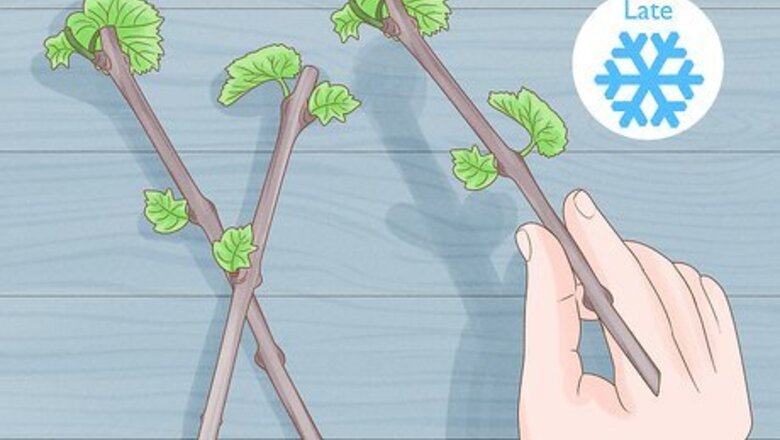
views
Taking Cuttings from Grape Vines
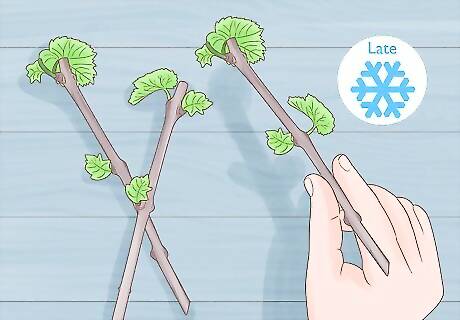
Gather hardwood cuttings in the late winter when your vines are dormant. Grapes grow throughout the summer, but they stop and go dormant through the fall and winter. Since the vines could dry out after you cut them, wait until the late winter so they’re in storage for a shorter time before you plant them. Greenwood cuttings are when you take vines from the current growing season during the summer. Varieties like muscadine grapes only grow from cuttings taken in the summer.
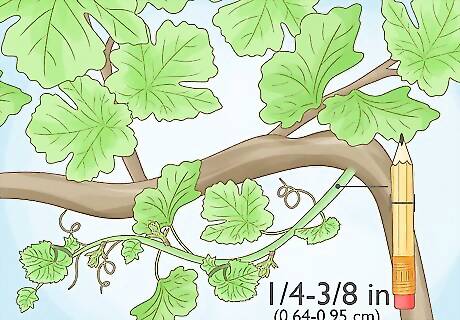
Choose vines as thick as a pencil that grew in the previous year. Since older vines produce less fruit, always pick the newest vines from the season for your cuttings. Check that they’re about ⁄4–⁄8 inch (0.64–0.95 cm) in diameter since anything smaller or larger may not grow as easily. If a vine has any damage or disease, pick a healthier-looking vine instead.

Cut a 14–16 in (36–41 cm) section with at least 3 buds. Once you find a vine, pick a node, which is the raised area on the vine with a bud, close to the stem. Use pruning shears to make your cut just below the node. Measure 14–16 in (36–41 cm) down the vine and make your second cut so it's 1–2 inches (2.5–5.1 cm) past a node. It’s okay if your vine has more than 3 buds, but stay away from vines where the nodes are spaced further apart.
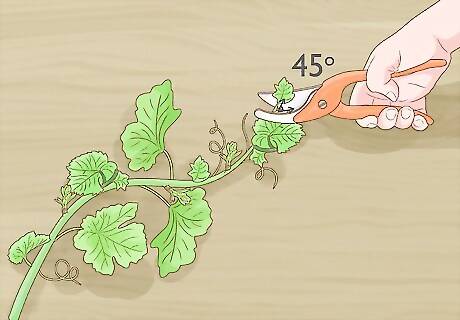
Trim the top end of the vine at an angle. Grape vine cuttings will only grow roots from the bottom and new vines from the top. To make it easier to tell which ends of the cuttings are the top and bottom, use your shears to cut a 45-degree angle on the end above the top node. The angled cut also helps water run off the stem so it’s less likely to develop rot while it’s growing.

Store vines with peat moss in the fridge until spring to keep them moist. Wet some peat moss and squeeze all the excess moisture out. Lay plastic wrap down and spread half of the peat moss on it. Then, put your cuttings on the peat moss. Completely cover the vines with another layer of moss. Roll the plastic up and tie it shut to keep the vines moist. Keep the vines in your fridge up until the late spring. Your peat moss is dry enough when your hand feels damp after you squeeze it. If your hand is still soaking wet, then the moss has too much moisture. If you’re collecting stems from multiple varieties of grapes, bundle each group of cuttings separately and label them.
Planting Grape Vine Cuttings

Plant your cuttings in the spring after the last frost. Grape vines won’t survive temperatures that drop below −15 °F (−26 °C), so check the weather and your local frost dates. In the late spring as the soil and weather start to warm up, you can take your cuttings out and get them ready for the next growing season.

Soak your cuttings in hot water to kill bacteria and fungi. Fill a bath or bowl with water that’s around 115–125 °F (46–52 °C) and drop in your cuttings. Leave them in the water for around 5–10 minutes to fully disinfect them from any potential diseases. While many people recommend using rooting hormones, grape vines grow just fine after soaking them in water. Rooting hormones could actually prevent your vines from forming healthy roots.
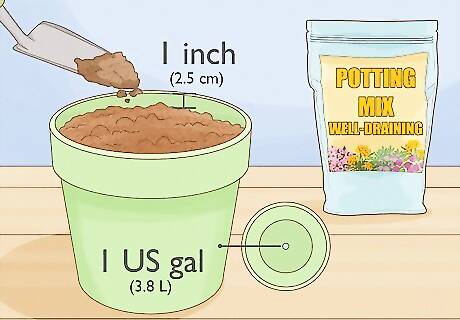
Fill 1 US gal (3.8 L) pots with potting mix. Make sure the pots you get have drainage holes at the bottom so excess water leaks out. Grapes grow best in sandy loam soils, but you can use any well-draining potting mix. Leave about 1 inch (2.5 cm) of space between the top of the soil and the lip of the pot so you can water your cuttings without spilling. Grape vines grow best in loose soil, so be careful not to press it down or compact it too much.
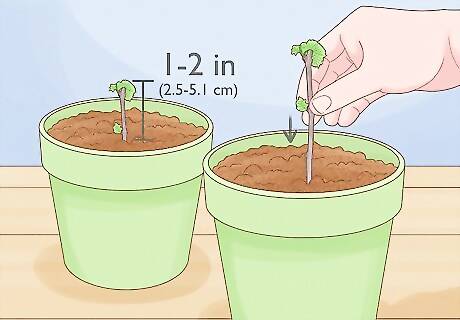
Push 1 cutting into each pot so the second bud is level with the soil. Stick to 1 cutting per pot so the roots get enough nutrients without any competition. Push the bottom of the cutting straight into the soil so it covers up the buds on the bottom. Leave about 1–2 inches (2.5–5.1 cm) of the cutting above the soil so 2 buds are showing. Press the soil firmly around the cutting to help support it. This helps your vines establish more roots instead of growing new shoots.
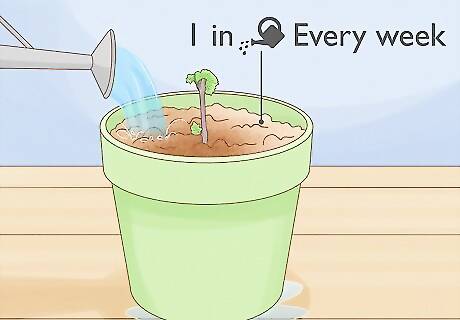
Water the soil whenever it feels dry to the touch. Use a watering can to lightly water the soil around your cutting. After adding a bit of water, wait to see if any drains out from the bottom of the pot. If not, add a little more water until you see the excess run out. When the soil feels dry about 1 inch (2.5 cm) below the surface, water the soil again. Your plants need around 1 inch (2.5 cm) of water every week. Too much water could cause your vines to develop rot.

Keep your pots in an area with at least 6 hours of sun per day. Grape vines grow best in warm, sunny locations, so set your pots outside or in a greenhouse where they get enough light. If there isn’t a spot that gets sunlight all day, then make sure the area is at least sunny in the morning. It’s alright if there’s a bit of shade covering your plant during the afternoon hours.
Transplanting Grape Vines

Move your grape vines into their final planting site the following spring. Leave your cutting to grow in a pot for its first year so it has a chance to develop healthy roots. After the cutting reaches 12 inches (30 cm) tall, you can plant it in the following spring while it’s still dormant. If you plant your grape vines too late in the spring, your vines won't grow as large or they may even die out.

Choose a planting spot with full sun. Look for a spot in your yard that gets at least 6 hours of sun throughout the entire day. If you have trouble finding a spot with consistent sunlight, pick a place that at least gets good sunlight in the morning since grapes can tolerate a little bit of shade in the afternoon. Your grapes are less likely to grow healthy vines or fruits if they’re grown somewhere without sunlight.

Pick an area with well-draining soil with a pH between 5.5–6.5. Run a soil test to check if your soil will work for your vines before you start planting. You can always amend the soil to raise or lower the pH, or you can find a different planting spot with better nutrients. To check the soil drainage, dig a 1 ft (30 cm) hole and fill it with water. After the hole drains, fill it again and measure the depth in 1 hour. If the water level goes down by 1–6 inches (2.5–15.2 cm), then your soil drains well. If you need to increase the pH, add lime or wood ash. If you need to lower the pH, add aluminum sulfate or sulfur. If you need to improve your soil drainage, try mixing in compost or manure to help.

Dig a hole large enough to fit the roots of your grapevine. Once you find the perfect planting area, use a shovel to make a hole that’s the same diameter and depth as the pot with your cutting. That way, you won’t have to bend or break any of the roots to make them fit. If you’re planting multiple cuttings in the ground, space them so they’re around 8–10 feet (2.4–3.0 m) apart.
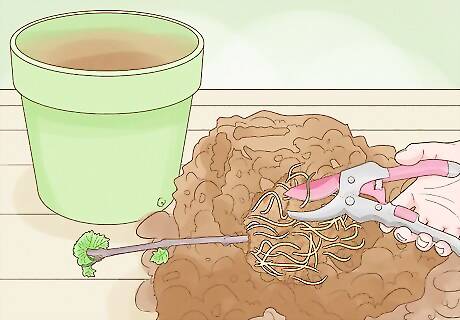
Prune any damaged or broken roots off of the plant. Gently loosen the soil in the pot and slowly pull your plant out. Break away any loose soil around the roots and look for any spots that are broken, soft, or diseased. Use your pruning shears to snip the damaged roots back down to the base. Soaking the roots in water may help break apart more soil and help you find damaged roots. Be sure to disinfect your shears with rubbing alcohol after cutting off the roots to prevent them from spreading diseases.

Set the roots in the hole and fill the soil back in. Carefully place your grape vine into the hole so it’s the same depth as it was in the pot. Fill the hole in with 6 inches (15 cm) of soil and tamp it down so it makes good contact with the roots. Then, fill in the hole so it’s level with the rest of the soil. Adding soil amendments to the hole, like compost or manure, can prevent the roots from expanding and growing strong, so only use regular topsoil.

Trim everything but the strongest stem down to the base of the plant. Use your pruning shears on the weaker stems branching off of the cutting. Trim them back down to the base of the plant to help the roots develop more. The strongest stem becomes the new main trunk for the rest of your vines.
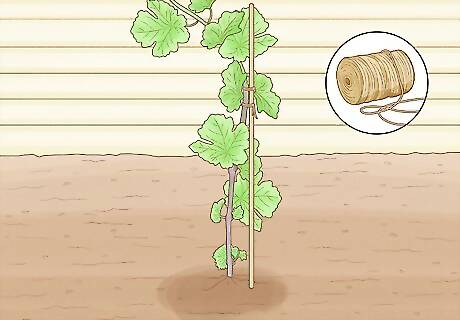
Tie the vine to a stake to help it grow upwards. Push a wooden or metal stake into the ground just next to the remaining stem. Use some garden twine or string to loosely tie the vine to the stake for support. This keeps your stem from bending and breaking while it grows.
Caring for Grape Vines
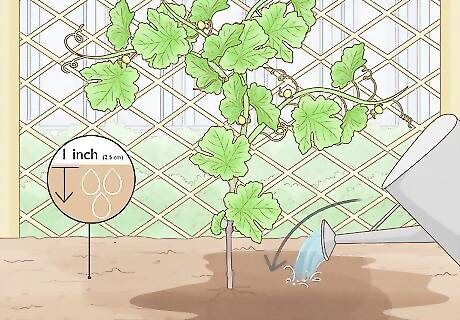
Water your vines every few days when the soil feels dry. Grapes easily get stressed when they’re over- or under-watered, so check the soil frequently. If it feels dry 1 inch (2.5 cm) below the surface, water the soil with a sprinkler or watering can until it feels damp. Drip irrigation systems work really well for keeping the soil moist without getting waterlogged.

Use netting and insect traps to protect your vines from pests. Some of the most common pests for grape vines are wasps and birds feeding on the fruit. You can use commercial wasp traps or make your own. If you’re worried about birds getting to underripe fruit, cover your entire vine with bird netting to keep them from landing or pecking at your plants. You can buy netting and traps from your local garden center.

Pull weeds whenever you see them around your plant. Weeds steal the nutrients from your plants, so it’s really important to remove them. Check around the base of your vines for new weed growth at least once a week. If you notice any, pull the entire plant up along with its roots so it’s less likely to grow back. Try covering the area around your plants with 1–2 inches (2.5–5.1 cm) of mulch to keep weeds from coming back.

Apply a 10-10-10 fertilizer every year to help stimulate growth. A 10-10-10 fertilizer contains equal amounts of nitrogen, phosphorus, and potassium. Only apply ½ cup (113 g) of fertilizer for every grape vine during the first growing year. Spread the fertilizer in the summer in a thin band about 1 ⁄2 ft (0.46 m) away from the vine so the roots can easily absorb the nutrients. During the second and third growing years, use 1 cup (227 g) of fertilizer instead. After the fourth year, you can use up to 2 cups (454 g).

Prune weak and spindly vines in the winter when they’re dormant. After the plant stops growing at the end of summer, look for any vines that look broken or thin. Use your pruning shears to cut the vines back down to the base of the stem. Trim the remaining vines growing from the stem so they only have about 3 buds on them during the first year. For the second growing year and each year after, prune the healthy vines so they have 6–10 buds on them. Choose 2 other healthy vines and cut them back to 2–3 buds.

Train your vines onto a trellis to help support your vines. Training your plants is when you cut or position the vines so they grow away from the main trunk. As your vines continue to grow, bend them down and tie them to horizontal wires to help them spread out and grow even more. From there, you can train the vines to keep growing horizontally or grow back down vertically. Training and trellising your grape vines help air flow through the vines so they don’t get too crowded.

Harvest fruits from your vines 5–6 years after establishing the plant. Growing grapes takes a lot of patience, and you won’t have any ripe fruits for a few years. Once your vines produce some healthy grapes, just use your pruning shears to cut the entire cluster off of the stem. Grapes are ready to harvest when they’re plump and juicy with rich colors.



















Comments
0 comment